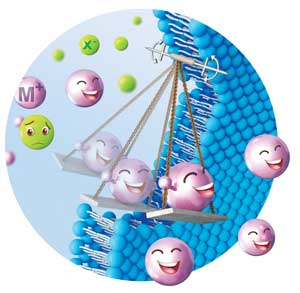| May 23, 2019 | |
Molecules swing electrolytes across membranes to kill cancer cells(Nanowerk News) Researchers from Singapore have designed the world’s first ‘molecular swing’ to transport electrolytes across cell membranes. In a recent paper ("Molecular Swings as Extremely Active Ion Transporters"), the scientists from NanoBio Lab (NBL) and Institute of Bioengineering and Nanotechnology of the Agency for Science, Technology and Research (A*STAR) demonstrated that their new mechanism transported potassium ions 27% faster than gramicidin A, a naturally occurring highly active peptide transporter. |
|
| When applied to brain tumor cells, this increase in speed inhibited cancer cells faster than potassium channel blocking drugs like quinidine. This suggests that the molecular swings could be potent anti-cancer agents. | |
 |
|
| Illustration of potassium ions being transported across a cell membrane by the molecular swing. (Image: A*STAR) | |
| According to Dr. Huaqiang Zeng, NBL Team Leader and Principal Research Scientist, “We are delighted that our unconventional molecular swing design functioned successfully. Its ability to efficiently and selectively transport potassium ions better than a natural transporter encouraged us to investigate its possible use in cancer chemotherapy.” | |
| Said Professor Jackie Y. Ying, A*STAR Senior Fellow and head of NBL, “We hope that our promising results will motivate others to create different types of motional channels for transmembrane transport that may lead to practical medical benefits in the future. This field of research has the potential to revolutionize medicine with more effective anti-cancer drugs and antibiotics.” | |
| Electrolytes are electrically charged chemicals and minerals, which play an important role in the body. They help to maintain key body functions, such as regulating the osmotic pressure in cells, stimulating muscles to contract and transmitting nerve signals. One essential electrolyte is the potassium ion, which helps to regulate blood pressure and maintain a normal heart rhythm. | |
| In order for our organs to function properly, we need an appropriate balance of electrolytes in our body. Typically, electrolytes move in and out of cells via carriers or channels. Carrier molecules facilitate ion transport by undergoing dramatic conformational changes, while channel molecules penetrate membranes to form pathways for ions to travel easily. Recently, researchers have been trying to replicate real-world macroscopic functions at the microscopic level using molecules. These developments in artificial molecular machines inspired the research team to design a new type of ion transport mechanism based on swing motion. | |
| The molecular swing anchors itself firmly to a cell’s lipid membrane via two cholesterol groups. Its other parts include one linear hydrazide segment that acts as the beam, one flexible oligoethylene glycol chain as the rope, and one crown ether as the seat. The crown ether binds to a potassium or sodium ion, and transports it across the membrane when there is a difference in ion concentration between the interior and exterior of the cell. | |
| As potassium ions move out of the cells, the over-accumulation of positively charged ions outside the cells depolarizes their neurons. This causes the neurons to become less capable or even incapable of transmitting signals, leading to cell death. The researchers showed that molecular swings precipitated this killing process in brain cancer cells more rapidly than anti-cancer drugs that block potassium channels to hinder ion transfer. | |
| The researchers are currently optimizing the structure of the molecular swing to enhance its anticancer activity. They are also testing other novel ion transport mechanisms. |
| Source: A*STAR | |
|
Subscribe to a free copy of one of our daily Nanowerk Newsletter Email Digests with a compilation of all of the day's news. |
